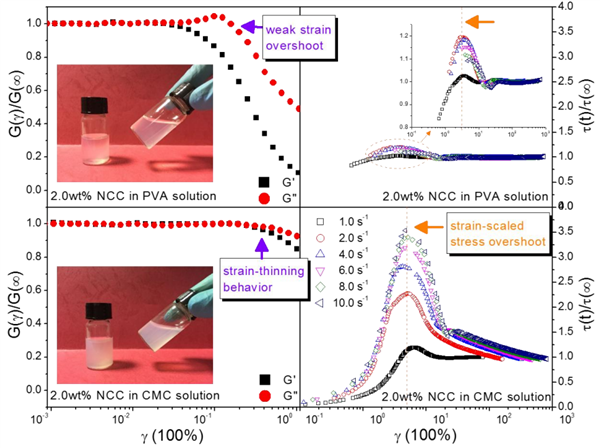作者:Yang Chen, Chunjiang Xu, Jing Huang, Defeng Wu*, Qiaolian Lv
关键字:nanocrystalline cellulose (NCC); suspension; polymer solution; rheology.
论文来源:期刊
具体来源:Carbohydrate Polymers
发表时间:2017年
Carbohydrate Polymers, 2017, 157C, 303-310.

ABSTRACT:
Rheological
behavior, including linear and nonlinear, as well as transient rheology of nanocrystalline
cellulose (NCC) suspensions was studied in this work. Two kinds of polymer
solutions, aqueous poly(vinyl alcohol) (PVA) with flexible chain structure and
aqueous carboxymethyl cellulose (CMC) with semi-rigid chain structure, were
used as the suspension media to further explore the role that the interactions among NCC and polymers played during shear flow. The results reveal that
NCC has lower values of percolation threshold in the PVA solution than in the
CMC one during small
amplitude oscillatory shear (SAOS) flow because
the flexible PVA chain has higher adsorbed level onto NCC particles than the negatively charged semi-rigid CMC chain,
which is further confirmed by the Fourier transformed
infrared (FT-IR) spectroscopy tests.
As a result, the NCC suspension shows a weak
strain overshoot in PVA solution during large amplitude oscillatory shear (LAOS) flow, which cannot be seen on the one in CMC solution.
During startup shear flow, both of these two suspensions
show evident stress overshoot behavior with the strain-scaling characteristics, indicating the formation
of ordered long-term structure of rod-like NCC particles with self-similarity during flow. However, NCC suspension have far stronger stress overshoot
response in CMC solution relative to the one in PVA solution. A possible synergy
mechanism between NCC and CMC chain is hence proposed.
PDF DOWNLOADED:
http://www.sciencedirect.com/science/article/pii/S0144861716311614